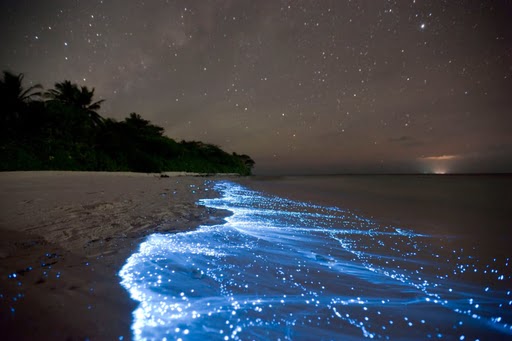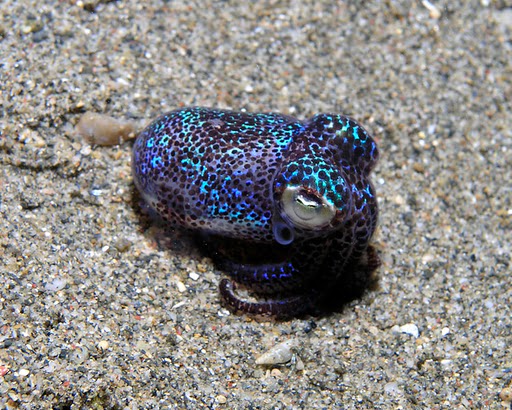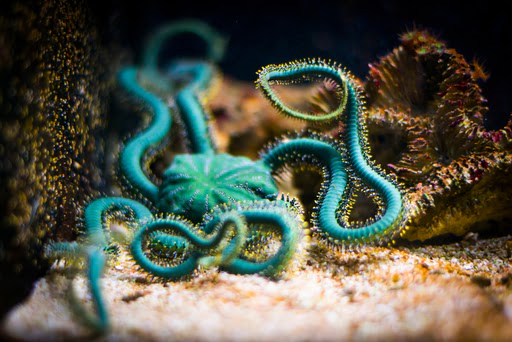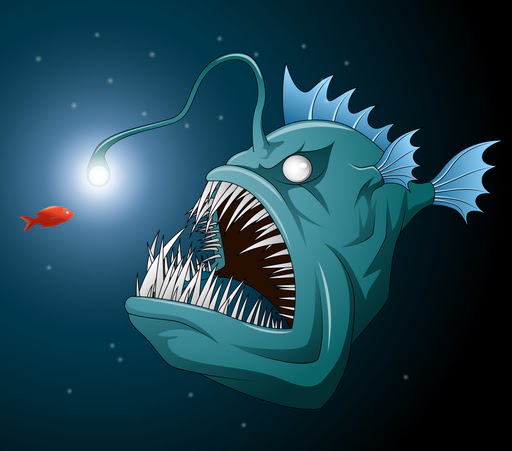Bioluminescence is responsible for creating a sea full of stars. This natural phenomenon occurs when certain living organisms undergo a chemical reaction that produces light without heat.
Imagine walking along the beach at night, enjoying the soothing sound of the waves and the cool breeze. As you stroll along the coastline, the waves gently touch your feet. Just as you’re about to wade deeper into the water, you notice that the water is glowing, as if the night sky has descended onto the beach!
Curious, you take a closer look and discover that the glowing sources are actually friendly algae.
However, not all beaches exhibit this mesmerizing glow.
 Bioluminescence in ocean waves. (Photo Credit : Isabella Miller/ Shutterstock)
Bioluminescence in ocean waves. (Photo Credit : Isabella Miller/ Shutterstock)
So, what causes these particular beaches to glow like fairy lights? The answer is simple: bioluminescence.
Fireflies are a well-known example of animals that possess this ability to emit light. Bioluminescence plays a crucial role in marine communication and is extensively studied to understand predator-prey interactions. When a living organism produces light through a chemical reaction, it is called bioluminescence.
Which Marine Organisms Exhibit Bioluminescence?
Not only algae, but other marine organisms such as certain bacteria, jellyfish, worms, crustaceans, and fish can also emit light. In some cases, marine animals consume bioluminescent organisms, like bacteria, and acquire the ability to glow. The Hawaiian bobtail squid is an example of such an animal.
 Hawaiian bobtail squid (Photo Credit : Nick Hobgood/Wikimedia Commons)
Hawaiian bobtail squid (Photo Credit : Nick Hobgood/Wikimedia Commons)
While multicellular organisms are more commonly associated with bioluminescence, unicellular organisms called dinoflagellates are also known to exhibit this ability. Dinoflagellates are marine creatures, and the species Noctiluca scintillans, also known as sea sparkle, is one of the many dinoflagellate species that produce bioluminescence when disturbed. Bioluminescence serves as a defense mechanism to startle predators. Dinoflagellates can be found in coastal waters worldwide. Despite their enchanting appearance, they are often referred to as “sea ghosts” or “fire of the sea.” Instead of using their scientific name, it’s easier to describe them as sea ghosts!
What Color is Bioluminescence?
Why does bioluminescence in the sea appear blue-green rather than red, pink, or yellow?
To find the answer, we need to understand wavelengths. Let’s start by considering the depth of the ocean. The ocean is so deep that sunlight cannot reach the ocean floor, resulting in minimal or no reflection from the ocean bed.
The different colors of the sea are caused by the absorption and scattering of light. When white light enters the sea water, only the red, yellow, and green light is absorbed, while the blue light is reflected back to us. The absorption of light is strong for some regions of the visible spectrum, but weak for blue light. The scattering effect of water molecules causes this blue light to be reflected back to us. At the shore, water molecules interact with sand and gravel, resulting in additional scattering of light. Certain algae, like Noctiluca scintillans, can absorb certain wavelengths of light and reflect back blue light, creating the illusion of an ocean full of stars.
Marine bioluminescence is caused by a chemical reaction that occurs within living organisms. This reaction, known as bioluminescence, produces “cold light” with less than 20% of the light producing heat. The reaction requires a substrate called luciferin and an enzyme called luciferase. Some microorganisms can produce luciferin on their own. When luciferin reacts with luciferase in the presence of oxygen, it forms a byproduct called oxyluciferin and water, resulting in the production of light. The oxidized luciferin becomes inactive.
What is the Reason for the Bioluminescence in Organisms?
Bioluminescence in many organisms serves as a defense mechanism or a way to confuse predators. For example, the vampire squid lacks ink sacks and instead releases a sticky bioluminescent liquid to startle and confuse potential predators. Similarly, the brittle starfish can detach a part of its body that produces light, distracting predators and allowing the starfish to escape.
 Brittle starfish. (Photo Credit : ewaplesna/ Shutterstock)
Brittle starfish. (Photo Credit : ewaplesna/ Shutterstock)
On the other hand, some marine organisms have evolved to use bioluminescence as a means of attracting prey. The anglerfish is a well-known example of a predator that uses bioluminescence to lure smaller fish. With a glowing bulb-like growth on its head, the anglerfish entices curious prey to approach, only to be eaten by the hidden predator.
 An artist’s depiction of the anglerfish. (Photo Credit : Jibon/ Shutterstock)
An artist’s depiction of the anglerfish. (Photo Credit : Jibon/ Shutterstock)
While it is important to be cautious around glowing objects in the sea, the allure of bioluminescence is certainly captivating. This fascinating phenomenon, observed in certain marine creatures and terrestrial insects, once again demonstrates the awe-inspiring wonders of nature!
